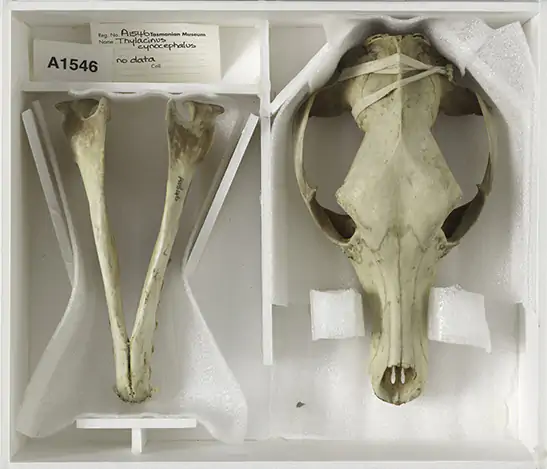The body of the last known living Tasmanian tiger was thought to be lost forever, but researchers have rediscovered the animal's preserved pelt and skeleton in a museum cupboard in Tasmania.
Striped like a tiger, with a somewhat dog-like body, the Tasmanian tiger – or thylacine (Thylacinus cynocephalus) – is in fact a large marsupial, more closely related to quolls and numbats. The pouched mammals were once found across Australia, though by the early 20th century its range was limited to Tasmania.
We now know the remains of the final captive thylacine were accidentally included in an educational program that traveled from school to school, teaching students about the anatomy of these long-lost creatures.
Parts of the specimen's skin still show flattened fur where children were allowed to pat it. No one realized what they were handling at the time, and in the 1980s, the body was stored away and promptly forgotten about.
It's a rather sad conclusion to a tragic life. Having been illegally captured by a trapper named Elias Churchill in May of 1936, the older female thylacine was secretly sold to the now-closed Beaumaris Zoo in Hobart, where she would die of exposure just a few months later, on the night of September 7.
At the time, no one realized this would be the last Tasmanian tiger to grace a zoo. In fact, records suggest people were still hunting for wild thylacines well after 1936.
The hope of finding another survivor meant that the body of the final thylacine at Beaumaris Zoo wasn't celebrated or labeled in any special way.
"For years, many museum curators and researchers searched for its remains without success, as no thylacine material dating from 1936 had been recorded in the zoological collection, and so it was assumed its body had been discarded," says Robert Paddle, a comparative psychologist from the Australian Catholic University.
The treasure hunt was only recently reignited when Paddle and Kathryn Medlock, an honorary curator at the Tasmanian Museum and Art Gallery (TMAG), stumbled across an unpublished report.
It was written in a 1936/1937 log by the museum's taxidermist, and the passage mentioned that the thylacine that died in 1936, the last known living individual of its kind, had been gifted to TMAG.
But it wasn't in the museum's zoological section, where researchers had looked for it before. It was in the museum's education section.
"The skin was carefully tanned as a flat skin by the museum's taxidermist, William Cunningham, which meant it could be easily transported and used as a demonstration specimen for school classes learning about Tasmanian marsupials," says Medlock.

Peddle and Medlock are both hopeful that their rediscovery will finally put an end to the myths that surround the last Tasmanian tiger.
These falsehoods have been shared so widely and uncritically, they can even be found on the official web pages of the National Museum of Australia and the National Film and Sound Archive.
Both of these sites state that the last Tasmanian tiger in captivity was a male named Benjamin, but Paddle told the Australian Broadcasting Corporation that is an enduring myth.
While it's true that there was a male thylacine housed at the Beaumaris Zoo in 1935, his name was not Benjamin and he wasn't the last. That rumor was completely made up in the 1960s by someone who didn't even work at the zoo.
"It's an unfortunate myth," Paddle told Adam Langenberg at ABC News.
"It's time to remove it from the literature. It's so appalling Kathryn [Medlock] and I haven't even mentioned it in the [research] paper."
The male at Beaumaris may not have been the last captive thylacine, but he was the last to be filmed on camera. A 21-second, black-and-white video of the male Tassie tiger, taken in 1935 for a documentary, was recently digitized and released online.
In the shot, the male thylacine can be seen pacing in his zoo enclosure while excited visitors shake his cage. If you listen to the audio, a narrator can be heard saying, "this is the only one in captivity in the world."
But that statement, if it was true at the time, wasn't true for long.
The female thylacine captured by Churchill joined the zoo shortly after 'Benjamin' made his film debut, and according to the museum's records, she outlasted the male.
While it's likely there were thylacines left in the wild at this time, this was the final individual ever held at a zoo. Hunting is thought to have contributed to their eventual extinction across Tasmania, along with possible diseases and habitat disruption as Europeans encroached on the animal's remaining stronghold.
The last known thylacine's remains are now on display at TMAG for any curious visitors to see.
Paddle and Medlock's paper on their re-discovery will soon be available on the Australian Zoologist website.



